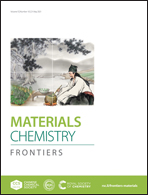Solid-state reversible optical switch based on two dendritic molecules with dual sensitivity of mechanochromism and photochromism†
Abstract
Efficient isomerization of photochromic molecules requires conformational freedom and is often limited to the solution or polymer matrix. Thus, developing a new method to improve photochromism in the solid state is quite necessary. In this work, we design and synthesize two dendritic photochromic molecules by incorporating spiropyran chromophores onto bisphenol A (BPA) or 1,1,1-tris(4-hydroxyphenyl)ethane (Tri-OH) via a mild esterification reaction, which show distinguished reversible photochromic properties in the solid state. Efficient isomerization is facilitated by large free volumes induced by the nonplanar molecular structures of bisphenol A or 1,1,1-tris(4-hydroxyphenyl)ethane moieties. Remarkably, these compounds also exhibit mechanochromic properties by mechanical forces. Compared with spiropyran chromophores, multichromophores B and C showed higher thermal decomposition temperatures and better reversible photoswitching properties in both solution and the aggregate state. In particular, the dendritic photochromic chromophores can form neat films directly without doping with any polymers and show a very high photochromic chromophore concentration. Further improvement in the photochromic properties was successfully achieved by doping these dendritic molecules with polymethyl methacrylate (PMMA), and films containing these molecules could be used for at least 100 cycles without apparent fatigue.



 Please wait while we load your content...
Please wait while we load your content...